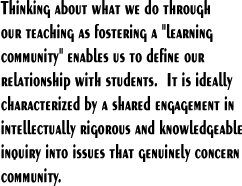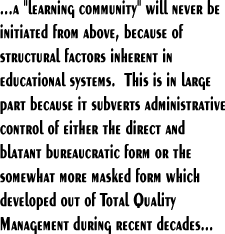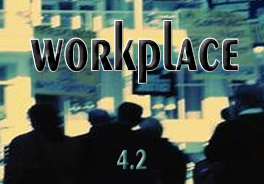1. As President of a university
chapter of the American
Association of University Professors, I have
been asked variants
of the same question: "What stake does the
community have in
university faculties' struggles against administration
efforts to
undermine our roles in university governance,
our autonomy in the
classroom, and our professional status?"
On two occasions, this
question was framed from the perspective
of workers: "What is the
stake for blue-collar workers and their families
in these
issues?" On the third occasion, the
question was framed from the
perspective of the social group with which
we share the classroom
on a daily basis: "What is the stake for
university students?"
2. As I thought about these variations of
the same question, two
corollary questions came to mind. One
is a restatement in
somewhat different terms, which sheds more
analytical light on
the significance of what was being asked:
"What makes our
struggle against administrative incursions
more than just a
battle over turf of no real interest to anyone
except ourselves?"
The second addresses the broader implications
of our
work as faculty activists: "What is it that
we stand for
ethically, socially, and pedagogically?"
This second question is
especially important, because it compels
us to think about what
we stand for, rather than just about what
we stand against. When
examined in combination, the two questions
are a reminder that
our struggles are interrelated with other
social struggles and
form part of a broader effort to redefine
and transform the
university in response to rapid social change.
3. To construct a viable response to these
related questions
requires those of us in the AAUP chapter
at the University of
Missouri-Kansas City to begin to clearly
identify what
differentiates our shared values and our
collaborative work to
change the university from the agenda of
administrative
leadership. Keeping in mind that I
am speaking as a member of
the AAUP (rather than as an officially delegated
spokesperson)
and as a member of the faculty in the School
of Education at the
University of Missouri-Kansas City, let me
begin that process
here. I only have time to give one
illustration: the proper
nature of our relationship with our students.
4. That relationship is not properly defined
in capitalist terms:
the relationship between customer and service
deliverer. Nor
should our academic programs which we as
faculty develop for
students be shaped by market research, customer
feedback,
managerial directive, or competition with
other institutions.
Rather, the appropriate nature of the relationship
between
university faculty and students is suggested
by a normative
concept currently in vogue in the educational
rhetoric: the
school or university as a "learning community."
While in
administrative rhetoric this concept is often
used in conjunction
with a capitalist model of academic programs
and of relations
between university and students, the depiction
of the university
as a "learning community" nevertheless suggests
a markedly
different way of viewing programs and relations
between
university and students--a way which is distinctly
non-capitalist.
5. Thinking about what we do through our teaching
as fostering a
"learning community" enables us to define
our relationship with
students. It is ideally characterized
by a shared engagement in
intellectually rigorous and knowledgeable
inquiry into issues
that genuinely concern community. Community
is understood as
both a "community of scholars" within the
university and the
broader set of metropolitan communities of
which the university
is a part. From the particular standpoint
of schools of
education, issues would include the complex
relationship between
what happens in educational institutions
and social-class
stratification. It would further require
investigation of the
extent of access to educational opportunity
afforded to different
social groups, as well as of those institutional
and cultural
factors internal and external to educational
systems which impede
or enhance access for each group. Furthermore,
it would require
study of the interrelationships among race
and ethnicity, gender,
and social class.
6. Issues would also include the nature of
an education which
genuinely contributes to social democracy.
This would entail
investigation of what educational experiences
and settings enable
individuals to develop the full range of
intellectual, social,
aesthetic, and vocational capabilities necessary
for democratic
citizenship. In addition, it would
entail inquiry into the
natures of a democratic society and democratic
social relations.
7. To fully prepare university students for
rigorous and
knowledgeable inquiry into issues of social
importance requires
in turn the sharpening of intellect and the
deep humanistic
insights afforded by the liberal arts--as
well as the discipline
methodologies of inquiry characteristic of
the social and natural
sciences at their best. In the case
of university educators (and
also of the school educators whom we teach),
the technical skills
necessary to be an effective educator need
to be cultivated
within this deep process of rigorous and
knowledgeable inquiry,
so that an educator can test techniques of
instruction,
curriculum development, or social relations
with students by
assessing the compatibility of technique
with the broad social
and ethical ends to which she/he is committed.
8. Such a "learning community" is, I think,
what we as an
organized and activist faculty need to be
working to create.
Creating it will require dialogue aimed at
identifying shared
educational and social values, using that
dialogue as a means to
develop collaborative relationships (among
ourselves and with our
students), building on what we already do
which is consistent
with such an understanding of engagement
in teaching and
learning, and identifying and changing what
we do which is
inconsistent with this understanding.
Such a "learning
community" will never be initiated from above,
because of
structural factors inherent in educational
systems. This is in
large part because it subverts administrative
control of either
the direct and blatant bureaucratic form
or the somewhat more
masked form which developed out of Total
Quality Management
during recent decades, and which has been
analyzed in educational
and corporate settings by researchers like
Denise Gelberg (1997)
and Mike Parker (1993). It can only
be initiated "from the
ground up" through the efforts of faculty
and students,
facilitated by those individual administrators
who value the
necessary collaboration and dialogue.
9. It is important to note that if such a
"learning community"
seeks to generate complex and accurate theoretical
understandings
of problems of importance to metropolitan
communities, as well as
potentially viable solutions informed by
those understandings,
then the means exist to establish strong
ties between faculty and
students, on the one hand, and community
members on the other.
If, furthermore, problems of justice, equality
of educational and
economic opportunity, and quality of individual
and community
life are especially emphasized in inquiry
within the "learning
community", then a basis exists for establishing
collaboration
and dialogue with individuals and groups
outside the university
who share an interest in these values and
in realizing them in
practice.
References
Gelberg, Denise. The "Business" of
Reforming American
Schools. Albany: State University
of New York Press, 1997.
Parker, Mike. "Industrial relations
myth and shop-floor reality:
the 'team concept' in the auto industry".
Industrial Democracy
in America: the Ambiguous Promise.
Eds. Nelson Lichtenstein and
Howell John Harris. Cambridge, U.K.:
Woodrow Wilson Center Press and Cambridge University Press, 1993.
249-74.
Stuart McAninch (stmcaninch@aol.com)
is Associate Professor of
Education, University of Missouri, Kansas
City and President of
the AAUP chapter at UMKC |


|
![]()
